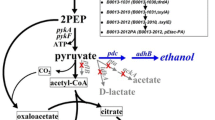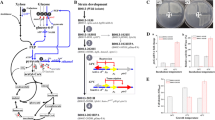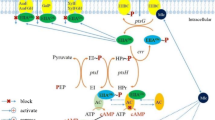Abstract
Hemicellulose hydrolysates of agricultural residues often contain mixtures of hexose and pentose sugars. Ethanologenic Escherichia coli that have been previously investigated preferentially ferment hexose sugars. In some cases, xylose fermentation was slow or incomplete. The purpose of this study was to develop improved ethanologenic E. coli strains for the fermentation of pentoses in sugar mixtures. Using fosfomycin as a selective agent, glucose-negative mutants of E. coli KO11 (containing chromosomally integrated genes encoding the ethanol pathway from Zymomonas mobilis) were isolated that were unable to ferment sugars transported by the phosphoenolpyruvate-dependent phosphotransferase system. These strains (SL31 and SL142) retained the ability to ferment sugars with independent transport systems such as arabinose and xylose and were used to ferment pentose sugars to ethanol selectively in the presence of high concentrations of glucose. Additional fosfomycin-resistant mutants were isolated that were superior to strain KO11 for ethanol production from hexose and pentose sugars. These hyperproductive strains (SL28 and SL40) retained the ability to metabolize all sugars tested, completed fermentations more rapidly, and achieved higher ethanol yields than the parent. Both SL28 and SL40 produced 60 gl−1 ethanol from 120 gl−1 xylose in 60 h, 20% more ethanol than KO11 under identical conditions. Further studies illustrated the feasibility of sequential fermentation. A mixture of hexose and pentose sugars was fermented with near theoretical yield by SL40 in the first step followed by a second fermentation in which yeast and glucose were added. Such a two-step approach can combine the attributes of ethanologenic E. coli for pentoses with the high ethanol tolerance of conventional yeasts in a single vessel.
Similar content being viewed by others

References
Barbosa M de FS, Beck MJ, Fein JE, Potts D, Ingram LO (1992) Efficient fermentation of Pinus spp. acid hydrolysates by an ethanologenic strain of Escherichia coli. Appl Environ Microbiol 58:1182–1184
Beall DS, Ohta K, Ingram LO (1991) Parametric studies of ethanol production from xylose and other sugars by recombinant Escherichia coli. Biotechnol Bioeng 38:296–303
Beall DS, Ingram KO, Ben-Bassat A, Doran JB, Fowler DE, Hall RG, Wood BE (1992) Conversion of hydrolysates of corn cobs and hulls into ethanol by recombinant Escherichia coli B containing integrated genes for ethanol production. Biotechnol Lett 14:857–862
Bertin C, Rouau X, Thibault J-F (1988) Structure and properties of sugar beet fibres. J Sci Food Agric 44:15–29
Christensen BG, Leanza WJ, Beattie TR, Patchett AA, Arison BH, Ormond RE, Kuehl FA Jr, Albers-Schonberg G, Jardetzky O (1969) Phosphonomycin: structure and synthesis. Science 166:123–125
Cordaro JC, Melton T, Stratis JP, Atagun M, Gladding C, Hartman PI, Roseman S (1976) Fosfomycin resistance: selection method for internal and extended deletions of the phosphoenolpyruvate:sugar phosphotranferase genes of Salmonella typhimurium. J Bacteriol 128:785–793
Dombek KM, Ingram LO (1986) Determination of the intracellular concentration of ethanol in Saccharomyces cerevisiae during fermentation. Appl Environ Microbiol 51:197–200
Grohmann K (1993) simultaneous saccharification and fermentation of cellulosic substrates to ethanol. In: Saddler JN (ed) Bioconversion of forest and agricultural residues. CAB International, Wallingford, UK, pp 183–209
Gunetileke KG, Anwar RA (1966) Biosynthesis of uridine diphospho-N-acetylmuramic acid. J Biol Chem 241:5740–5743
Hahn-Hägerdal B, Hallborn J, Jeppsson H, Olsson L, Skoog K, Walfridsson M (1993) Pentose fermentation to alcohol. In: Saddler JN (ed) Bioconversion of forest and agricultural residues. CAB International, Wallingford, UK, pp. 231–290
Hendlin D, Stapley EO, Jackson M, Wallick H, Miller AK, Wolf FJ, Miller TW, Chaiet L, Kahan FM, Foltz EL, Woodruff HB, Mata JM, Hernandez S, Mochales S (1969) Phosphonomycin, a new antibiotic produced by strains of Streptomyces. Science 166:122–123
Ingram LO, Conway T, Clark DP, Sewell GW, Preston JF (1987) Genetic engineering of ethanol production in Escherichia coli. Appl Environ Microbiol 53:2420–2425
Kahan FM, Kahan JS, Cassidy PJ, Kropp J (1974) The mechanism of action of fosfomysin (phosphonomycin). Ann NY Acad Sci 235:364–386
Lawford HG, Rousseau, JD (1991) Fuel ethanol from hardwood hemicellulose hydrolysate by genetically engineered Escherichia coli B carrying genes from Zymomonas mobilis. Biotechnol Lett 13:191–196
Lawford HG, Rousseau JD (1993) Fermentation of newsprint hydrolysate by an ethanologenic recombinant Escherichia coli. Biotechnol Lett 15:505–510
Lin ECC (1970) The genetics of bacterial transport systems. Annu Rev Genet 4:225–262
Lin ECC (1987) Dissimilatory pathways for sugars, polyols and carboxylates. In: Neidhardt FC, Ingraham JL, Low KB, Magasanik B, Schaechter M, Umbarger HE (eds) Escherichia coli and Salmonella typhimurium cellular and molecular biology. ASM, Washington, DC, pp 244–284
Lynd LR, Cushman JH, Nichols RJ, Wyman CE (1991) Fuel ethanol from cellulosic biomass. Science 251:318–1323
Ohta K, Beall DS, Mejia JP, Shanmugam KT, Ingram LO (1991) Genetic improvement of Escherichia coli for ethanol production: chromosomal integration of Zymomonas mobilis genes encoding pyruvate decarboxylase and alcohol dehydrogenase. II. Appl Environ Microbiol 57:893–900
Postma PW, Lengeler JW, Jacobson GR (1993) Phosphoenol-pyruvate:carbohydrate phosphotransferase system of bacteria. Microbiol Rev 57:543–594
Puls J (1993) Substrate analysis of forest and agricultural wastes. In: Saddler JN (ed) Bioconversion of forest and agricultural plant residues. CAB International, Wallingford, UK, pp 13–32
Roseman S, Meadow ND (1990) Signal transduction by bacterial phosphotransferase system. J Biol Chem 265:2993–2996
Sambrook J, Fritsch EF, Maniatis T (1989) Molecular cloning: a laboratory manual, 2nd edn.Cold Spring Harbor Laboratory, Cold Spring Harbor, NY
Venkateswaran PS, Wu HC (1972) Isolation and characterization of phosphonomycin-resistant mutant of Escherichia coli K-12. J Bacteriol 110:935–944
Wu HC, Venkateswaran PS (1974) Fosfomycin-resistant mutants of Escherichia coli. Ann NY Acad Sci 235:587–592
Author information
Authors and Affiliations
Rights and permissions
About this article
Cite this article
Lindsay, S.E., Bothast, R.J. & Ingram, L.O. Improved strains of recombinant Escherichia coli for ethanol production from sugar mixtures. Appl Microbiol Biotechnol 43, 70–75 (1995). https://doi.org/10.1007/BF00170625
Received:
Revised:
Accepted:
Issue Date:
DOI: https://doi.org/10.1007/BF00170625



